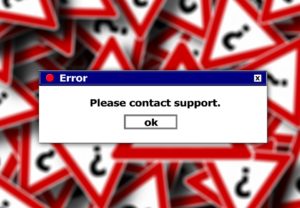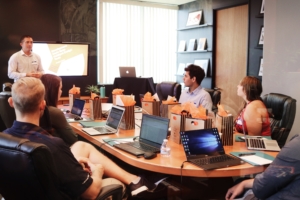Your Business Can Benefit From The Fourth Industrial Revolution
By Dan Hamon, Senior Consultant
In the words of President Teddy Roosevelt, “Sometimes a revolution is necessary.”

By Gerd Altmann
Now is that necessary time for business leaders. The global economy is in the midst of revolutionary technological innovations that are predicted to lead to supply-chain miracles, with long-term gains in efficiency and productivity.
That’s if you embrace the revolution and don’t fear the technological advances.
When it comes to mass adoption of technology, there was a silver lining to the pandemic. Many embraced technology solutions during the days of Covid lockdowns. The pandemic did not cause what has been dubbed the Fourth Industrial Revolution, but it did accelerate all sorts of technology adoption by many years.
The pandemic was a compelling demonstration of technology that accelerated adoption by 10 years or more. All the tools for remote calls and meetings and sharing documents were all there, but people were not fully using them. These technologies enabled businesses to continue and even prosper. Some say it was the crucible moment of the Fourth Industrial Revolution.
To understand this fourth revolution, it pays to examine the previous three.
The First Three Industrial Revolutions
Step back into history to examine the first three industrial revolutions. First came the steam engine in the 18th century, and industry no longer moved at the pace of a horse, Next came electricity in the 19th century during Teddy Roosevelt’s lifetime, and that powered mass production.

By Jim Semonik
Then in the mid-20th century came the power of computers, which led to the digital transformation of business. In the early 21st century we have entered the Fourth Industrial Revolution, set to change the world of work in ways previously imagined in sci-fi books and films.
Klaus Schwab, the person who labeled today’s advances as a new revolution, is a German engineer, economist, and founder of the World Economic Forum (WEF). He has acted as the WEF’s chairman since founding the organization in 1971.
In his 2017 book, The Fourth Industrial Revolution, Schwab wrote that like the revolutions that preceded it, the Fourth Industrial Revolution “has the potential to raise global income levels and improve the quality of life for populations around the world.”
According to Schwab, “Transportation and communication costs will drop, logistics and global supply chains will become more effective, and the cost of trade will diminish, all of which will open new markets and drive economic growth.”
Simply put, The Fourth Industrial Revolution is the current and developing environment in which disruptive technologies and trends that are changing how we work and live, such as artificial intelligence, virtual reality, robotics, and what’s dubbed “The Internet of Things.”
What Really Is The Internet of Things
The Internet of Things (IoT), a subset of the Fourth Industrial Revolution, describes physical objects embedded with sensors and actuators that communicate with computing systems via wired or wireless networks—allowing the physical world to be digitally monitored or even controlled.
By Pixelkult
Here are startling statistics: According to data from Giancarlo Mori at MVYL Associates and Lori Lewis at All Access, during one minute on the internet 700,000 Instagram stories are shared and 9,000 LinkedIn connections are made. In a minute, 500 hours of YouTube content is uploaded. A total of $1.6 billion is spent online every minute. That’s fueling this Fourth Industrial Revolution.
Lighthouse Consulting works with B2B software clients that are at the intersection of deploying advanced technologies to solve complex problems to deliver compelling business results. Our clients are organizations that are doing big things: like semiconductor design software, high speed computing hardware and supply chain solutions.
As an example, in one instance we helped a client in the cold supply chain space whose business is all about using technology to monitor and ensure the quality and safety of food during transport.
Typically, we work alongside the owner/CEO to help implement their vision while also refining the strategy. We roll up our sleeves and assist with the implementation.
Strong Yet Opposing Views Of Technology
As a society we seem to concurrently hold two strong yet opposing attitudes about technology. People let gadgets rule their lives (hello Siri and Alexa), and yet we actively dismiss the smallest of inquiries as to how those gadgets work.
Sci-fi films and sensational media coverage are encouraging fear. But in my opinion business leaders need to be ready to experiment. Leaders need to be curious and open about technology. People need to step out of their comfort zone.

By thisisengineering-raeng
These disruptive technologies are not new, AI has been around for more than 50 years and its consumer applications have been in our midst for at least 20 of those years. Robotics has made a huge impact on manufacturing.
But recent sci-fi movies play upon the fears of data science, robots, and AI. Here is a recap of the 2013 film Her, starring Juaquin Phoenix and Scarlet Johanson. Consider this plot synopsis from IMDB website:
Theodore (Phoenix) is a lonely man in the final stages of his divorce… He decides to purchase the new OS1, which is advertised as the world’s first artificially intelligent operating system, “It’s not just an operating system, it’s a consciousness,” the ad states. Theodore quickly finds himself drawn in with Samantha (Johanson), the voice behind his OS1. As they start spending time together, they grow closer and closer and eventually find themselves in love. Having fallen in love with his OS, Theodore finds himself dealing with feelings of both great joy and doubt.
Sure, Siri and Alexa are helpful, but are we in danger of falling in love? Another sci-fi film to examine our new reality is from 2014 titled Ex Machina, starring Alicia Vikander and. Domhnall Gleeson. Here is the plot synopsis from the IMDB website:
Caleb (Gleeson), a 26-year-old programmer at the world’s largest internet company, wins a competition to spend a week at a private mountain retreat belonging to Nathan, the reclusive CEO of the company. But when Caleb arrives at the remote location, he finds that he will have to participate in a strange and fascinating experiment in which he must interact with the world’s first true artificial intelligence, housed in the body of a beautiful robot girl (Vikander).
Data science and AI are closely related. They’re not the same thing, but they rely on each other. If you’re open to taking all your sales data at every stage of the sales cycle and doing some serious analysis on it, you will find insights. You will find trend lines, and opportunities for growth that you’ve never seen before without these tools.
Business leaders should care about these tools because the barriers to entry for creators and entrepreneurs will come down. The creation, market adoption, and distribution of intellectual property will expand dramatically, There’ll be huge opportunities to create value and scaling any of those types of businesses will be cheaper and faster.
The possible opportunities are made possible by advances in computer science algorithms, high performance computing architectures, widely available and constantly improving semiconductor design, chip design manufacturing techniques, and almost infinite and basically free cloud storage.
Which Businesses Will Benefit The Most?
Companies of all sizes will be positively impacted. Small companies can develop and get products to market faster at lower costs. Some experts I’ve spoken with claim that experienced software engineers can be 30% more productive when paired with AI bots. That means companies can make either 30% more products or become 30% more valuable.

By Riccardo Annandale
Medium and large companies can leverage data sets and create models that will revolutionize healthcare consumer products, law, and other areas. I would not be surprised if a high-tech company buys a national hospital chain just for AI purposes. Why would they do that? Having ownership of vast amounts of radiology imaging data would be a compelling reason to invest billions of dollars because then you can create probably the most advanced AI model to identify early-stage cancer without any IP violations.
Small law firms and other professional services businesses are already leveraging tools from AI to do administrative marketing, content generation and automation of intensive tasks. Obviously, this is going to increase even more.
Other studies suggest that if you pair AI with a domain expert like a lawyer or a surgeon, you’ll get much, much better results than if you have the human expert alone or the AI expert alone. That will be like a super genius assistant that is right next to you, enabling you to do more and do better.
To learn more about how you might take advantage of the Fourth Industrial Revolution and other services offered by the Business Consulting for Higher Productivity Division, please email dhamon@lighthouseconsulting.com.
Daniel Hamon is a Senior Consultant in the Business Consulting For Higher Productivity Division at Lighthouse Consulting LLC. He has played key leadership roles in product development, marketing, sales, and worldwide operations and P&L. He is particularly gifted at drawing together and leading the right internal and external teams for solving complex problems, including business turnarounds. His industry expertise includes software, semiconductors, micro-electro-mechanical systems, high performance computing, cybersecurity, data encryption, crowdfunding, and artificial intelligence (AI).
Lighthouse Consulting Services, LLC – Testing Division provides a variety of services, including in-depth work style & personality assessments for new hires & staff development. LCS can test in 19 different languages, skills testing, domestic and international interpersonal coaching and offer a variety of workshops – team building, interpersonal communication. Business Consulting for Higher Productivity Division provides stress & time management workshops, sales & customer service training and negotiation skills, leadership training, market research, staff planning, operations, ERP/MRP selection and implementation, refining a remote work force, M&A including due diligence – success planning – value creation and much more.
To order the books, “Cracking the Personality Code”, “Cracking the Business Code” and “Cracking the High-Performance Team Code”, please go to www.lighthouseconsulting.com.
Permission is needed from Lighthouse Consulting Services, LLC to reproduce any portion provided in this article. © 2023










 siblings, pets, or a close group of friends. They probably sacrifice for them and spend most of their free time with them.
siblings, pets, or a close group of friends. They probably sacrifice for them and spend most of their free time with them. An “I’m sorry” gift doesn’t necessarily have to cost a lot; it depends on how big the mistake was.
An “I’m sorry” gift doesn’t necessarily have to cost a lot; it depends on how big the mistake was.























 An accurate assessment by a sales performance expert with detailed findings and recommendations
An accurate assessment by a sales performance expert with detailed findings and recommendations